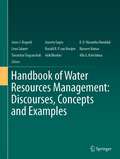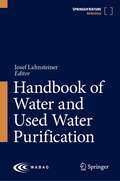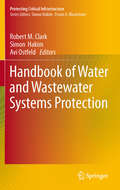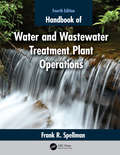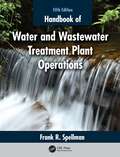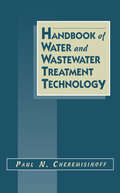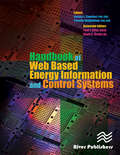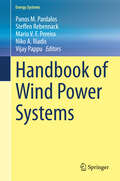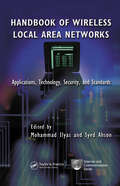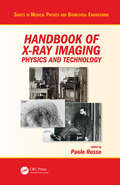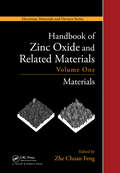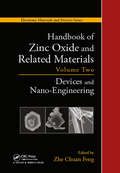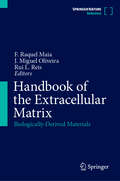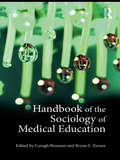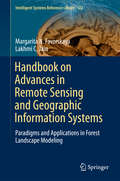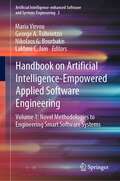- Table View
- List View
Handbook of Water Pollution
by Inamuddin Tariq Altalhi Arwa AlrooqiHANDBOOK of WATER POLLUTION Handbook of Water Pollution discusses a wide range of contaminants heavily affecting our environment and water bodies. The chapters discuss heavy metals, metalloids, pesticides, explosives, toxic chemicals, dyes, plastics, e-wastes, fertilizers, detergents, nitrates/nitrites, phosphates, hydrocarbons, and fecal wastes, along with their sources of action against our environment, their methods of analysis, and finally, their treatments are all presented in detail. Our environment is heavily affected due to extreme human activities. Environmental pollution is a major concern worldwide. Within this, water pollution is one of the major challenges that puts the total ecology at risk. Water pollution is alarming everywhere; many governing authorities believe it is also an unavoidable result of human activity. However, the economic cost of water pollution far outweighs the benefits of skimping on its cause. Water pollution is not just merely related to financial cost but related to all living beings. Toxic waste is getting into the water bodies in various regions, causing many illnesses in humans and poisoning other living things. The destruction of any single component of our ecosystem can have a devastating effect on our biodiversity. Therefore, it is necessary to understand the causes of pollution, their nature and mechanism, and, at the same time, study the remedies. The major causes of water pollution are industrial waste, sewage, plastics, oil leakage, biological organisms, toxic chemicals and radioactive waste, and so on. A tremendous amount of research work is going on around the world to understand the causes, their mechanism, and solutions. Many new works are published every day, therefore it’s important to gather some of the most relevant findings in one place. This will serve as a link between collected knowledge and current advancements, while also facilitating future thinking.
Handbook of Water Resources Management: Discourses, Concepts and Examples
by Joyeeta Gupta Anik Bhaduri Janos J. Bogardi K. D. Wasantha Nandalal Léna Salamé Ronald R. P. van Nooijen Navneet Kumar Tawatchai Tingsanchali Alla G. KolechkinaThis book provides an overview of facts, theories and methods from hydrology, geology, geophysics, law, ethics, economics, ecology, engineering, sociology, diplomacy and many other disciplines with relevance for concepts and practice of water resources management. It provides comprehensive, but also critical reading material for all communities involved in the ongoing water discourses and debates.The book refers to case studies in the form of boxes, sections, or as entire chapters. They illustrate success stories, but also lessons to be remembered, to avoid repeating the same mistakes. Based on consolidated state-of-the-art knowledge, it has been conceived and written to attract a multidisciplinary audience.The aim of this handbook is to facilitate understanding between the participants of the international water discourse and multi-level decision making processes. Knowing more about water, but also about concepts, methods and aspirations of different professional, disciplinary communities and stakeholders professionalizes the debate and enhances the decision making.
Handbook of Water and Used Water Purification
by Josef LahnsteinerThe book addresses the entire water cycle. The focus is on new technologies/processes (especially in high performance biological treatment), energy recovery, water recycling and reuse. Recommendations with regard to the right technologies/processes for specific situations are provided and a wide range of case studies, especially in emerging markets. In addition, the most modern water terminology with more positive connotations is used. This is especially important in the field of direct and indirect potable reuse (DPR and IPR respectively).
Handbook of Water and Wastewater Systems Protection
by Simon Hakim Avi Ostfeld Robert M. ClarkFollowing the events of 9/11, the Administrator of the US Environmental Protection Agency created the Water Protection Task Force (WPTF), which identified water and wastewater systems as a major area of vulnerability to deliberate attack. The WPTF suggested that there are steps that can be taken to reduce these vulnerabilities and to make it as difficult as possible for potential saboteurs to succeed. The WPTF recommended that be scrutinized with renewed vigor to secure water and wastewater systems against these possible threats. It also recommended that water and wastewater systems have a response plan in place in the event an act of terrorism occurs. The WPTF identified water distribution networks as an area of special vulnerability and highlighted the need for rapid on-line detection methods that are accurate and have a wide detection range. As a result of these recommendations novel technologies from various fields of science and engineering are now addressing water security issues and water and wastewater utilities are looking for innovative solutions. Once such technologies are available, there will be a rapid implementation process that will present many business opportunities for the private sector. However, in addition to terrorist threats water and wastewater systems are inherently vulnerable to natural disasters such as earthquakes and floods. This volume will address the problems associated with both intended terrorist attacks and natural disasters affecting water or wastewater systems. The book is divided into parts based on the kinds of threats facing water and wastewater systems: (1) a direct attack on water and wastewater infrastructure storage reservoirs, and distribution and collection networks; (2) a cyber attack disabling the functionality of the water and wastewater systems or taking over control of key components which might result in system failures; and (3) a deliberate chemical or biological contaminant injection at one of the water distribution system's nodes. It will examine unique plans, technological and managerial innovations for protecting such systems, and includes descriptions of projects that were implemented to respond to natural disasters. Case studies are presented that discuss existing projects and evaluate their performance, with an emphasis on providing guidelines and techniques that can be implemented by water and wastewater planners and managers to deal with natural and manmade disasters should they occur.
Handbook of Water and Wastewater Treatment Plant Operations
by Frank R. SpellmanThe Handbook of Water and Wastewater Treatment Plant Operations is the first thorough resource manual developed exclusively for water and wastewater plant operators. Now regarded as an industry standard, this fourth edition has been updated throughout, and explains the material in easy-to-understand language. It also provides real-world case studies and operating scenarios, as well as problem-solving practice sets for each scenario. Features: Updates the material to reflect the developments in the field Includes new math operations with solutions, as well as over 250 new sample questions Adds updated coverage of energy conservation measures with applicable case studies Enables users to properly operate water and wastewater plants and suggests troubleshooting procedures for returning a plant to optimum operation levels Prepares operators for licensure exams A complete compilation of water science, treatment information, process control procedures, problem-solving techniques, safety and health information, and administrative and technological trends, this text serves as a resource for professionals working in water and wastewater operations and operators preparing for wastewater licensure exams. It can also be used as a supplemental textbook for undergraduate and graduate students studying environmental science, water science, and environmental engineering.
Handbook of Water and Wastewater Treatment Plant Operations
by Frank R. SpellmanThe Handbook of Water and Wastewater Treatment Plant Operations is the first thorough resource manual developed exclusively for water and wastewater plant operators. Now regarded as an industry standard, this fifth edition has been updated throughout, and it explains the material in easy-to-understand language. It also provides real-world case studies and operating scenarios, as well as problem-solving practice sets for each scenario. Key features: Updates the material to reflect the developments in the field Includes new math operations with solutions, as well as over 250 new sample questions Adds updated coverage of energy conservation measures with applicable case studies Enables users to properly operate water and wastewater plants and suggests troubleshooting procedures for returning a plant to optimum operation levels Prepares operators for licensure exams
Handbook of Water and Wastewater Treatment Technology
by Paul N. CheremisinoffOffers information on the treatment of water and wastewater for municipal, sanitary and industrial applications, focusing on unit operations and processes that serve the broadest range of users. Wastewater treatement unit operations, including filtration, flotation, chemical coagulation, flocculation and sedimentation, as well as advanced technolog
Handbook of Weaving
by Sabit AdanurA mixture of science and art, weaving is nearly as old as human history. Despite the many technological advances in the field, however, it is still virtually impossible to control each individual fiber in a woven structure. To help you meet this and other weaving challenges, Handbook of Weaving covers every step of the process clearly and systemati
Handbook of Web Based Energy Information and Control Systems
by Barney L. Capehart Timothy MiddelkoopThis book promotes the benefits of the development and application of energy information and control systems. This wave of information technology (IT) and web-based energy information and control systems (web based EIS/ECS) continues to roll on with increasing speed and intensity. This handbook presents recent technological advancements in the field, as well as a compilation of the best information from three previous books in this area. The combined thrust of this information is that the highest level functions of the building and facility automation system are delivered by a web based EIS/ECS system that provides energy management, facility management, overall facility operational management and ties in with the enterprise resource management system for the entire facility or the group of facilities being managed.
Handbook of Wind Energy Aerodynamics
by Bernhard Stoevesandt Gerard Schepers Peter Fuglsang Yuping SunThis handbook provides both a comprehensive overview and deep insights on the state-of-the-art methods used in wind turbine aerodynamics, as well as their advantages and limits. The focus of this work is specifically on wind turbines, where the aerodynamics are different from that of other fields due to the turbulent wind fields they face and the resultant differences in structural requirements. It gives a complete picture of research in the field, taking into account the different approaches which are applied. This book would be useful to professionals, academics, researchers and students working in the field.
Handbook of Wind Power Systems
by Panos M. Pardalos Niko A. Iliadis Steffen Rebennack Vijay Pappu Mario V. F. PereiraWind power is currently considered as the fastest growing energy resource in the world. Technological advances and government subsidies have contributed in the rapid rise of Wind power systems. The Handbook on Wind Power Systems provides an overview on several aspects of wind power systems and is divided into four sections: optimization problems in wind power generation, grid integration of wind power systems, modeling, control and maintenance of wind facilities and innovative wind energy generation. The chapters are contributed by experts working on different aspects of wind energy generation and conversion.
Handbook of Wind Resource Assessment
by Simon WatsonHANDBOOK OF WIND RESOURCE ASSESSMENT Useful reference text underpinning the theory behind wind resource assessment along with its practical application Handbook of Wind Resource Assessment provides a comprehensive description of the background theory, methods, models, applications, and analysis of the discipline of wind resource assessment, covering topics such as climate variability, measurement, wind distributions, numerical modeling, statistical modeling, reanalysis datasets, applications in different environments (onshore and offshore), wind atlases, and future climate. The text provides an up-to-date assessment of the tools available for wind resource assessment and their application in different environments. It also summarizes our present understanding of the wind climate and its variability, with a particular focus on its relevance to wind resource assessment. Written by a highly qualified professional in the fields of wind resource assessment, wind turbine condition monitoring, and wind turbine wake modeling, sample topics included in Handbook of Wind Resource Assessment are as follows: Climate variability, covering temporal scales of variation, power spectrum, short term variation and turbulence, the spectral gap, and long-term variation Measurement, covering history of wind speed measurement, types of measurement, terrestrial measurements, anemometers, wind vanes, lidars, sodars and remote sensing Distributions, covering synoptic scale wind distributions, turbulent scale distributions, contrast between mean and extreme values, and extreme value statistics Physical modeling, covering spatial scales of variability, the governing equations, models of varying complexity, mass consistent models, linearized models and semi-empirical models Statistical modeling, covering the use of measure-correlate-predict (MCP), wind indices and spatial interpolation Handbook of Wind Resource Assessment serves as a comprehensive text that brings together the different aspects of wind resource assessment in one place. It is an essential resource for anyone who wishes to understand the underlying science, models, or applications of wind resources, including postgraduates, academics, and wind resource professionals.
Handbook of Wireless Local Area Networks: Applications, Technology, Security, and Standards (Internet and Communications)
by Mohammad Ilyas Syed AhsonConsisting of 25 articles contributed by expert authors from around the world, this handbook begins with a detailed introduction that provides an overview of LAN technologies, performance, security, and security protocols. It then delves further into WLAN technology, covering space-time processing, WLAN and cellular convergence, and a peer-to-peer approach to roaming, along with other topics. The Handbook continues by exploring WLAN applications, followed by an extensive discussion of security that includes the steps that can be taken to minimize WLAN security risks. This text concludes with an analysis of standards, describing 3G UMTS - IEEE 802.11b internetworking and security.
Handbook of Wireless Sensor Networks: Issues and Challenges in Current Scenario's (Advances in Intelligent Systems and Computing #1132)
by Wei-Chiang Hong Pradeep Kumar Singh Marcin Paprzycki Narottam Chand Kaushal Bharat K. BhargavaThis book explores various challenging problems and applications areas of wireless sensor networks (WSNs), and identifies the current issues and future research challenges. Discussing the latest developments and advances, it covers all aspects of in WSNs, from architecture to protocols design, and from algorithm development to synchronization issues. As such the book is an essential reference resource for undergraduate and postgraduate students as well as scholars and academics working in the field.
Handbook of Wood Chemistry and Wood Composites
by Roger M. RowellWood has played a major role throughout human history. Strong and versatile, the earliest humans used wood to make shelters, cook food, construct tools, build boats, and make weapons. Recently, scientists, politicians, and economists have renewed their interest in wood because of its unique properties, aesthetics, availability, abundance, and perha
Handbook of X-ray Imaging: Physics and Technology (Series in Medical Physics and Biomedical Engineering)
by Paolo RussoContaining chapter contributions from over 130 experts, this unique publication is the first handbook dedicated to the physics and technology of X-ray imaging, offering extensive coverage of the field. This highly comprehensive work is edited by one of the world’s leading experts in X-ray imaging physics and technology and has been created with guidance from a Scientific Board containing respected and renowned scientists from around the world. The book's scope includes 2D and 3D X-ray imaging techniques from soft-X-ray to megavoltage energies, including computed tomography, fluoroscopy, dental imaging and small animal imaging, with several chapters dedicated to breast imaging techniques. 2D and 3D industrial imaging is incorporated, including imaging of artworks. Specific attention is dedicated to techniques of phase contrast X-ray imaging. The approach undertaken is one that illustrates the theory as well as the techniques and the devices routinely used in the various fields. Computational aspects are fully covered, including 3D reconstruction algorithms, hard/software phantoms, and computer-aided diagnosis. Theories of image quality are fully illustrated. Historical, radioprotection, radiation dosimetry, quality assurance and educational aspects are also covered. This handbook will be suitable for a very broad audience, including graduate students in medical physics and biomedical engineering; medical physics residents; radiographers; physicists and engineers in the field of imaging and non-destructive industrial testing using X-rays; and scientists interested in understanding and using X-ray imaging techniques. The handbook's editor, Dr. Paolo Russo, has over 30 years’ experience in the academic teaching of medical physics and X-ray imaging research. He has authored several book chapters in the field of X-ray imaging, is Editor-in-Chief of an international scientific journal in medical physics, and has responsibilities in the publication committees of international scientific organizations in medical physics. Features: Comprehensive coverage of the use of X-rays both in medical radiology and industrial testing The first handbook published to be dedicated to the physics and technology of X-rays Handbook edited by world authority, with contributions from experts in each field
Handbook of Zeolite Science and Technology
by Scott M. Auerbach Kathleen A. Carrado Prabir K. DuttaThe Handbook of Zeolite Science and Technology offers effective analyses ofsalient cases selected expressly for their relevance to current and prospective research. Presenting the principal theoretical and experimental underpinnings of zeolites, this international effort is at once complete and forward-looking, combining fundamental
Handbook of Zinc Oxide and Related Materials: Volume One, Materials
by Zhe Chuan FengThrough their application in energy-efficient and environmentally friendly devices, zinc oxide (ZnO) and related classes of wide gap semiconductors, including GaN and SiC, are revolutionizing numerous areas, from lighting, energy conversion, photovoltaics, and communications to biotechnology, imaging, and medicine. With an emphasis on engineering a
Handbook of Zinc Oxide and Related Materials: Volume Two, Devices and Nano-Engineering
by Zhe Chuan FengThrough their application in energy-efficient and environmentally friendly devices, zinc oxide (ZnO) and related classes of wide gap semiconductors, including GaN and SiC, are revolutionizing numerous areas, from lighting, energy conversion, photovoltaics, and communications to biotechnology, imaging, and medicine. With an emphasis on engineering a
Handbook of the Extracellular Matrix: Biologically-Derived Materials
by Rui L. Reis J. Miguel Oliveira F. Raquel MaiaThis book comprises 6 sections covering the fundamentals of the extracellular matrix, as well as the development and challenges of using biologically-derived materials, and its advanced biomedical applications. The first section is dedicated to the extracellular matrix, while the other 5 sections are each dedicated to a particular type of material. This book reports the fundamentals of the extracellular matrix and its impact on the development of innovative materials; provides an overview of the advanced methodologies used to develop biologically-derived materials; and describes the challenges of the synthesis and processing of the different materials. Furthermore, it presents the biological activities, structural and physicochemical properties of such materials, and the modification methods pursued to improve their inherent properties. The wide range of advanced applications are covered as well, including the combination with emerging technologies, underlying tissue-engineered scaffolding, drug delivery systems, 3D in vitro tissue and cancer models, 3D bioprinted models, bioinks, and more. This reference work serves as a core reference for multidisciplinary students (undergraduates and Ph.D. students) and a wide range of established researchers and professionals working in the medical field, e.g., orthopaedics, radiology, dentistry, and cancer.
Handbook of the Sociology of Medical Education
by Bryan S. Turner Caragh BrosnanThe Handbook of the Sociology of Medical Education provides a contemporary introduction to this classic area of sociology by examining the social origin and implications of the epistemological, organizational and demographic challenges facing medical education in the twenty-first century. Beginning with reflections on the historical and theoretical foundations of the sociology of medical education, the collection then focuses on current issues affecting medical students, the profession and the faculty, before exploring medical education in different national contexts. Leading sociologists analyze: the intersection of medical education and social structures such as gender, ethnicity and disability; the effect of changes in medical practice, such as the emergence of evidence-based medicine, on medical education; and the ongoing debates surrounding the form and content of medical curricula. By examining applied problems within a framework which draws from social theorists such as Pierre Bourdieu, this new collection suggests future directions for the sociological study of medical education and for medical education itself.
Handbook on Advanced Design and Manufacturing Technologies for Biomedical Devices
by Andrés Díaz LantadaThe last decades have seen remarkable advances in computer-aided design, engineering and manufacturing technologies, multi-variable simulation tools, medical imaging, biomimetic design, rapid prototyping, micro and nanomanufacturing methods and information management resources, all of which provide new horizons for the Biomedical Engineering fields and the Medical Device Industry. Advanced Design and Manufacturing Technologies for Biomedical Devices covers such topics in depth, with an applied perspective and providing several case studies that help to analyze and understand the key factors of the different stages linked to the development of a novel biomedical device, from the conceptual and design steps, to the prototyping and industrialization phases. Main research challenges and future potentials are also discussed, taking into account relevant social demands and a growing market already exceeding billions of dollars. In time, advanced biomedical devices will decisively change methods and results in the medical world, dramatically improving diagnoses and therapies for all kinds of pathologies. But if these biodevices are to fulfill present expectations, today's engineers need a thorough grounding in related simulation, design and manufacturing technologies, and collaboration between experts of different areas has to be promoted, as is also analyzed within this handbook.
Handbook on Advances in Remote Sensing and Geographic Information Systems
by Lakhmi C. Jain Margarita N. FavorskayaThis book presents the latest advances in remote-sensing and geographic information systems and applications. It is divided into four parts, focusing on Airborne Light Detection and Ranging (LiDAR) and Optical Measurements of Forests; Individual Tree Modelling; Landscape Scene Modelling; and Forest Eco-system Modelling. Given the scope of its coverage, the book offers a valuable resource for students, researchers, practitioners, and educators interested in remote sensing and geographic information systems and applications.
Handbook on Applications of Ultrasound: Sonochemistry for Sustainability
by Ackmez Mudhoo Sanjay K. Sharma Dong ChenUltrasonic irradiation and the associated sonochemical and sonophysical effects are complementary techniques for driving more efficient chemical reactions and yields. Sonochemistry-the chemical effects and applications of ultrasonic waves-and sustainable (green) chemistry both aim to use less hazardous chemicals and solvents, reduce energy consumpt
Handbook on Artificial Intelligence-Empowered Applied Software Engineering: VOL.1: Novel Methodologies to Engineering Smart Software Systems (Artificial Intelligence-Enhanced Software and Systems Engineering #2)
by Lakhmi C. Jain Maria Virvou George A. Tsihrintzis Nikolaos G. BourbakisThis book provides a structured overview of artificial intelligence-empowered applied software engineering. Evolving technological advancements in big data, smartphone and mobile software applications, the Internet of Things and a vast range of application areas in all sorts of human activities and professions lead current research towards the efficient incorporation of artificial intelligence enhancements into software and the empowerment of software with artificial intelligence. This book at hand, devoted to Novel Methodologies to Engineering Smart Software Systems Novel Methodologies to Engineering Smart Software Systems, constitutes the first volume of a two-volume Handbook on Artificial Intelligence-empowered Applied Software Engineering. Topics include very significant advances in (i) Artificial Intelligence-Assisted Software Development and (ii) Software Engineering Tools to develop Artificial Intelligence Applications, as well as a detailed Survey of Recent Relevant Literature. Professors, researchers, scientists, engineers and students in artificial intelligence, software engineering and computer science-related disciplines are expected to benefit from it, along with interested readers from other disciplines.

